Aichi is blessed with mountains, sea and an abundance of foods. Apart from the established Nagoya Meshi cuisine, there are many more local gourmet treats in the area.
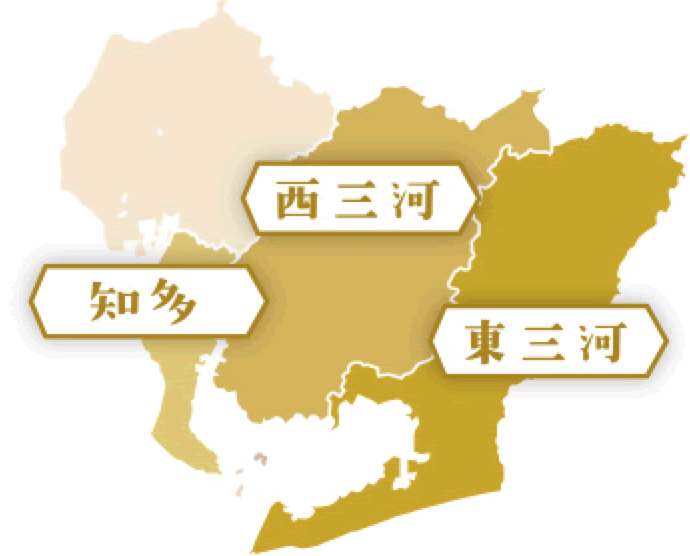

From underneath the curry udon, tororo gohan (rice with grated yam) appears!
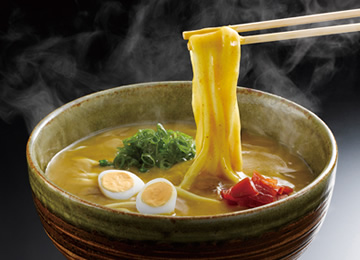
After eating the Udon, try mixing the remaining curry with Tororo Gohan rice with grated yam for double the pleasure!
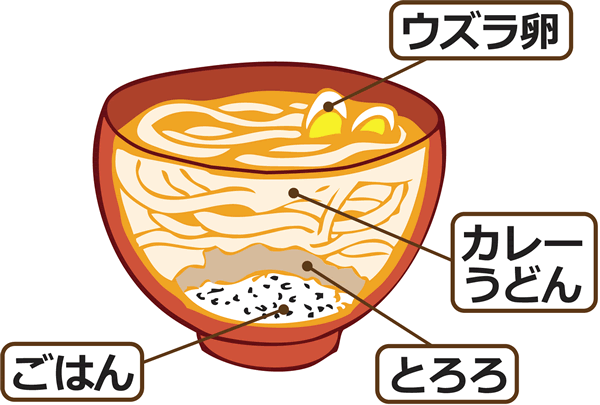
Ingredients include
The rule is to eat the above mentioned trimmings in that order, and to save enough curry to enjoy them.Toyohashi City
Toyohashi Curry Udon
Toyohashi is a city with a strong Udon culture. Among the many Udon restaurants, handmade Udon is common. Toyohashi curry Udon debuted in spring 2010 and is currently sold at over 40 establishments. Each restaurant offers their own variety, so you can enjoy visiting and trying them all!
Menu Characteristics
Home made noodles are used as a top layer hiding a surprise serving of Tororo Gohan underneath the Curry Udon. Toyohashi quail eggs, sliced soy pickled vegetables or daikon radish, and red pickled ginger are a must. The final, most important requirement is… to make it with love!
The taste of Mikawa Bay, clam flavoured udon noodles.
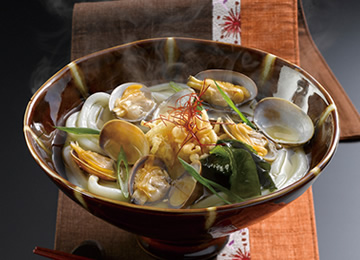
Mikawa Bay is the nation’s leading clam production area. The rich soup and the wakame’s salty aroma match well.
Gamagori City
Gamagori Udon
Nishiura fishing port was once used as a wintertime movie location. Local fishermen presented the crew with a large amount of clams, which led to the creation of Gamagori Udon, which won the Grand Prix in the following years’ Udon Summit. Over 30 restaurants across Gamagori serve the dish, with numbers increasing.
Menu Features
Over five clams in their shells are included in the soy-flavored soup. To be considered authentic, at least one of five Gamagori ingredients, such as seasame oil, smelt, fish paste, mexicali, wakame seaweed and the like, must be added.
Mikawa Bay is Japans’ leading producer of clams. The area’s rich soup and salty aroma of the wakame go together well.
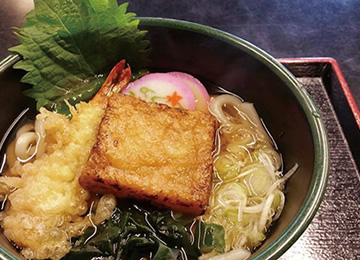
Mikawa people love both Inarizushi and Udon, making this the ideal combination!
Toyokawa City
Toyokawa Inari Udon (Udon with sticky rice wrapped in fried bean curd)
In the footsteps of Toyokawa Inarizushi comes Inari Udon, developed in 2010, and using Inari-mochi, sticky rice wrapped in fried bean curd as a main ingredient. The unique dish is salty-sweet and most addictive. It is similar to, but different from Kitsune Udon, being udon with fried bean curd, and Chikara Udon, with its sticky rice cake. Inari Udon is currently sold at four locations in Toyohashi.
Menu Characteristics
Inari-mochi is sticky rice served in an envelope of fried bean curd, and then further cooked. The delicious aroma is enhanced by each shop’s original serving style. There are three types of soup, the standard, curry and the thick, starchy Ankake type. A treasure trove of clams at Atsumi.
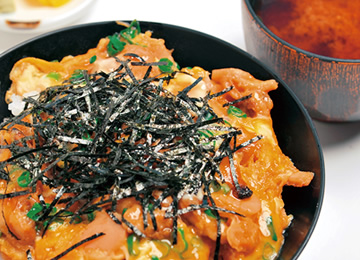
It is most common to pour soy sauce on the large clams and grill them. For rice bowls, variations include tempura and binding in egg.
Tahara City
Large clams served on rice.
Tahara City ranked number 1 in national gross agricultural production in 2006. Additionally, it is a seafood treasure trove surrounded on three sides by the sea. The ‘Atsumi Peninsula Donburi (rice bowl) Road,’ takes advantage of these strengths, with 41 participating restaurants. Each restaurant uses various local ingredients to appeal to customers. The large clam donburi is the representative local dish.
Menu Characteristics
Approximately 25% of the restaurants on the ‘Atsumi Peninsula Donburi Road’ serve the large local clams on rice. Each restaurant uses diverse preparation methods like frying, tempura battering, broiling etc., to bring out the best of the ingredients.
White soy sauce is the key to this refined Japanese yakisoba pan-fried noodle dish.
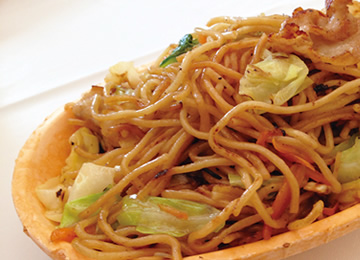
Edible trays made of Ebi Senbei crackers are often found at local events.
Hekinan City
Hekinan Pan-fried Yakisoba Noodles
This local soba uses Hekinan’s original white soy sauce produced mainly in Nishi-mikawa as a seasoning. It debuted in 2010 and began to gain momentum after a volunteer team entered it in an event. Around 15 restaurants now serve Hekinan Yakisoba.
Menu Characteristics
White soy sauce is the main seasoning, with Hekinan’s prefectural production leading carrots and onions included.
Ebi Senbei (shrimp rice crackers), which are also said to have originated in Hekinan, are characterized by its refined, mellow taste.

Genuine local foods created by local industry.
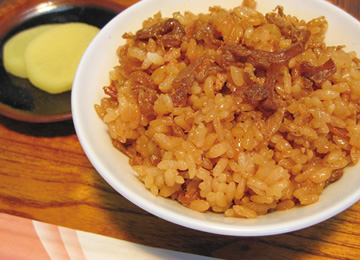
With a mellow sweetness, it is ideal cold, or served inside rice balls.
Takahama City
Takahama Tori-meshi Chicken Rice.
This local delicacy, chicken rice, was created by the local poultry industry when chickens which no longer laid eggs were culled and eaten. In 2010 the Takahama Tori-meshi (chicken rice) Society was inaugurated and began to enter Tori-meshi in food competitions. Currently over 17 specialty restaurants serve the dish.
Menu Characteristics
Thinly cut chicken, flavored with soy sauce and sugar, is mixed in with rice. Using older chickens provides a firmer texture than younger birds. Deep friend bean curd and carrot is also added in some areas. 
The high quality ingredients are value for money, and unique preparation methods are required too.
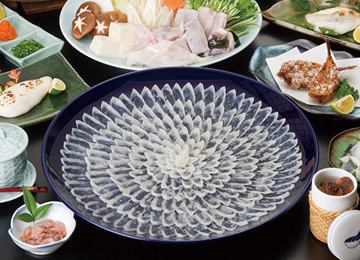
High quality finely cut fugu blowfish, can be enjoyed at reasonable prices between October and March.
Minami Chita-cho
Fugu (blowfish)
Shimonoseki in Japan’s southwest was long considered the home of the Fugu, blowfish, industry, however, since 2000, Aichi Prefecture claims the largest haul of blowfish, and now exports it to Shimonoseki! Recently, local consumption has increased, and so traditional inns and restaurants are training their staff in the preparation and serving of the fish. Around 150 fugu fishing vessels now ply the clear Minami Chita waters bringing home the prized delicacy.
Menu Characteristics
Gyosho-yaki is fish grilled in a delicious fish sauce, the secret ingredient being anchovy caught in Minami Chita’s Toyohama Port. The fish is slowly grilled over hot coals and delivers a soft, juicy texture and a unique aroma.
